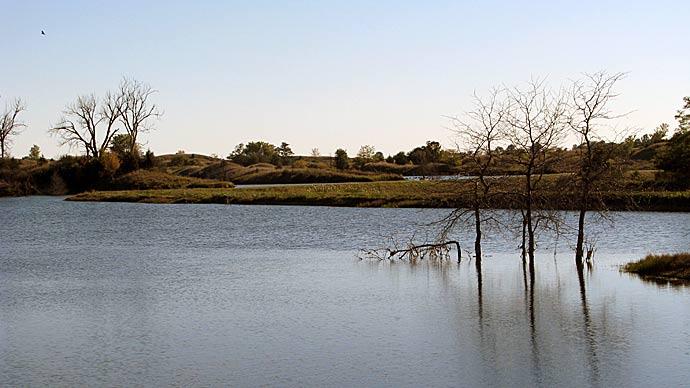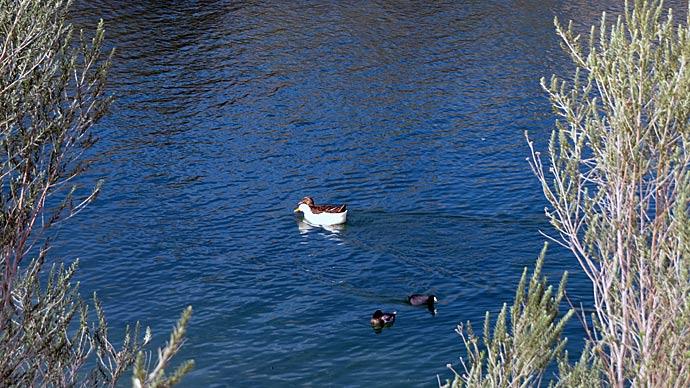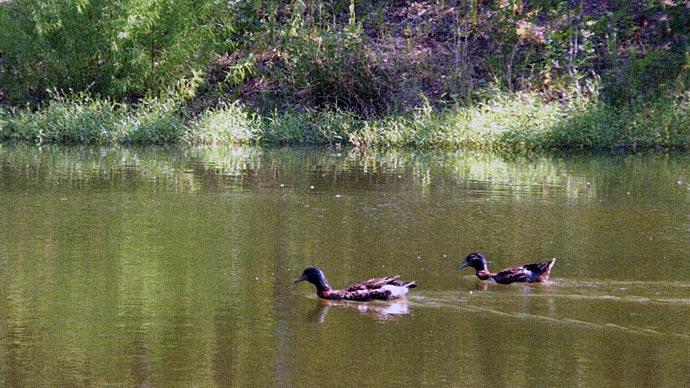Dirt's different. Everywhere. To see what I mean, just dig a hole, and look at the different types of dirt. A Natural Resources Conservation Service guy told me once that there's more than 50,000 different kinds of dirt, from sand to rock to topsoil to clay to shale. And soil-types vary from place to place.
For the pond owner, figuring out what to do with dirt is a big secret to the success of a pond building adventure. Dirt can be used to fine-tune a pond site and turn it into a real first-class fishery. That was never more obvious than at a new site I worked last summer along the Oklahoma-Texas border.
The landowner is fisheries biologist Bob Lusk of the Field Advisory Staff and his wife, Debbie. They recently purchased a rustic home on 11 acres about a quarter-mile from Lake Texoma, north of Dallas. A lazy sort of guy who's allergic to lawn mowers, and totally enamored with fish, Lusk wanted to cover up as much of his 11 acres with water as possible.
From the highest point on the southwest corner, to the lowest point, a creek headed into Lake Texoma, there's a vertical fall of 90 feet. That's right, 90 feet. This much topical relief, or what I call "fall," presents a challenge for any pond designer.
Throw in the facts the best spot for a pond is directly beside his house, and the soils are like a sieve, and we had some tough decisions to make.
Bob's pond dam may be the first I ever built where none of the dam site soils came from the dam site. None.
After discussing our options, digging test holes, plotting strategy and talking some more - Lusk likes to talk - we decided to push the existing dirt away from the proposed dam site. In its place, I would dig a 15-foot core trench, then build a core with two different types of clay material I found elsewhere on the property.
Bob had already drilled a water well, to supply his workshop and fish vat shed. On the highest point of land sat a deep layer of pure red clay, with limited watershed drainage. Below the proposed pond site sat a small meadow with crumbly white clay, with small rock particles, slightly under a 20-inch layer of topsoil. We decided to use both types of material in the core.
And, the dam was designed to block a small canyon. After going down with the trench, we would have to go up more than 30 feet to refill the core trench, and to build a dam on top of this solid foundation. That would take a lot of dirt.
So, instead of one pond, maybe an acre and a half, we built him two hatchery ponds to be filled with his well, the main pond, and an acre pond below the main pond. The property already had two small ponds, so with four more, the Lusk family has six ponds on their 11 acres.
The well fills the two hatchery ponds, which overflow into a smaller pond, which overflows into an existing pond, which overflows into the main pond, which overflows into the lower pond, which overflows into the creek.
Good water management. But, reading soils and mixing them properly was tricky. The site was small, which didn't leave me much room for my machines to maneuver, which made compacting the soils a little iffy at times.
We did this work in July and August, our dry season. So it wasn't easy compacting the soil. Ever tried to pack baby powder?
Using my scraper, we would pick up a load of dirt from the bottom pond site, dump it, then bring in a load of red clay from the high point, dump it. I kept the bulldozer moving the dirt back and forth, mixing, and crushing. Then, the scraper would bring another load of each, and the dozer would do its magic. Every third or fourth load, the heavy, rubber tire scraper would move back and forth, compacting soils mixed by the dozer. We would go up six inches, then add water by pumping from an old existing pond. Water was crucial to this project to ensure proper compaction, As the dam rose, we scarified each hillside, and added clay, to be sure we were able to properly tie the dam into the side of each hill. But, the secret to building this dam in poor soils was to move the bad soils out, and bring in good, tight clay soils, then mixing and packing these soils. This dam won't leak.
The real test in building Bob's ponds was being able to identify the poor soils, move them out of the way. Then we could find the best soils for building the dam. Mixing the marginal clay with heavy red clay proved to be a solid decision.
Believe it or not, the red clay was too pure. Had we built the dam from red clay only, it could have big cracks from time to time. Clay expands and contracts with heat and moisture. Mixing the good clay with marginal clay still allows the soils to hold water, but reduces the likelihood of expansion and contraction.
Here's the rest of the story.
The previous landowner happened to be an excavating contractor. On the site we chose for the main dam, he had pushed up a small levee. It was tiny, and leaked. A three-inch rain filled the tiny hole, and three weeks later, all the water would be gone, except for a puddle below natural ground level. Bad soils make a bad dam.
As we built the ponds, Lusk took care of fish structure. Several young oak trees stood below the water line, and Bob cut them down, and rearranged the upper end of the pond for fish structure.
Here's what he explained to me: Fish need cover. Different fish need different types of cover. Small fish need dense shoreline cover, like cedar trees, or thick aquatic plant growth.
Big fish like big cover. Largemouth bass, for example, like to hang out in fairly shallow water, quick access to deep, near a log, or big rock, off a point.
Bob took two mature oak trees, 30 feet tall, with canopy complete, and placed them perpendicular to shore. The root ball sits in water 4 feet deep, and the canopies push deeper, with limbs in water 4-10 feet deep.
We also added the root balls from about a dozen we cut down and pushed over. Lusk then brought in a stack of wooden pallets, three piles of rip-rap size limestone, leftover sheetrock from work on the house, and several stacks of tiles, cut up and placed along the northern shoreline. Toss in three piles of sawed cedar limbs, tied together and anchored, and the variety was complete.
Sandstone rocks, three to four feet across and two feet tall, were pulled from the lake bottom, and placed carefully at water's edge, adding a natural look. Native rocks add ambience and shoreline seats.
The upper end of this 1 1/2-acre recreational pond looks like an amusement park for fish, while the lower end is barren, designed for a dock and swimming fun.
Part of our finer aspects of dirt moving was to leave several areas of sharp drops, artificial creek channels, and slopes to enhance the fish cover while using the dirt on the downstream side of the dam.
The engineering was good, designing four ponds instead of just the main pond, then reading and fine tuning existing soils, molding and wetting, packing and working, made this project what it is.
Now, Lusk can sit on the porch and watch kids swim and watch fish jump - while the neighbors mow.
The author, who owns and operates Otto's Dirt Service, is a Pond Boss Field Advisor. Contact him at (800) 882-DIRT.
Reprinted with permission from Pond Boss Magazine



